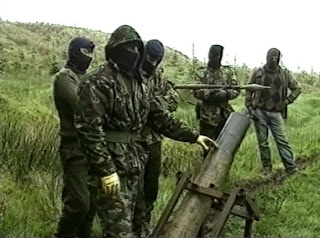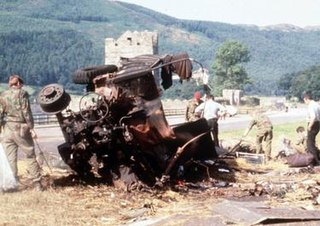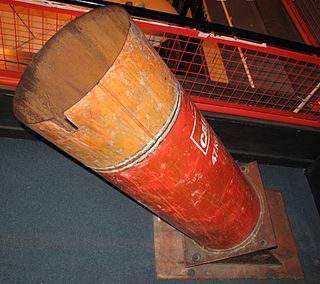
The East Tyrone Brigade of the Provisional Irish Republican Army (IRA), also known as the Tyrone/Monaghan Brigade was one of the most active republican paramilitary groups in Northern Ireland during "the Troubles". It is believed to have drawn its membership from across the eastern side of County Tyrone as well as north County Monaghan and south County Londonderry.

The South Armagh Brigade of the Provisional Irish Republican Army (IRA) operated during the Troubles in south County Armagh. It was organised into two battalions, one around Jonesborough and another around Crossmaglen. By the 1990s, the South Armagh Brigade was thought to consist of about 40 members, roughly half of them living south of the border. It has allegedly been commanded since the 1970s by Thomas 'Slab' Murphy who is also alleged to be a member of the IRA's Army Council. Compared to other brigades, the South Armagh IRA was seen as an 'independent republic' within the republican movement, retaining a battalion organizational structure and not adopting the cell structure the rest of the IRA was forced to adopt after repeated intelligence failures.

From 1969 until 1997, the Provisional Irish Republican Army (IRA) conducted an armed paramilitary campaign primarily in Northern Ireland and England, aimed at ending British rule in Northern Ireland in order to create a united Ireland.

The Warrenpoint ambush, also known as the Narrow Water ambush, the Warrenpoint massacre or the Narrow Water massacre, was a guerrilla attack by the Provisional Irish Republican Army (IRA) on 27 August 1979. The IRA's South Armagh Brigade ambushed a British Army convoy with two large roadside bombs at Narrow Water Castle outside Warrenpoint, Northern Ireland. The first bomb was aimed at the convoy itself, and the second targeted the incoming reinforcements and the incident command point (ICP) set up to deal with the incident. IRA volunteers hidden in nearby woodland also allegedly fired on the troops, who returned fire. The castle is on the banks of the Newry River, which marks the border between Northern Ireland and the Republic of Ireland.

Barrack buster is the colloquial name given to several improvised mortars, developed in the 1990s by the engineering unit of the Provisional Irish Republican Army (IRA).

Operation Conservation was an attempt by the British Army to ambush a large Provisional Irish Republican Army (IRA) unit along the Dorsey Enclosure, between Cullyhanna and Silverbridge, in south County Armagh. The action took place on 6 May 1990 but was thwarted by the South Armagh Brigade of the IRA.
The Glasdrumman ambush was an attack by the South Armagh Brigade of the Provisional Irish Republican Army (IRA) against a British Army observation post in Glasdrumman, County Armagh on 17 July 1981. An attempted ambush by the British Army on IRA members at a scrapyard southwest of Crossmaglen was itself ambushed, resulting in the death of one British soldier and the IRA retaining the ability to set up checkpoints in South Armagh.
The Drummuckavall ambush was an attack by the South Armagh Brigade of the Provisional Irish Republican Army (IRA) on a British Army observation post in Drummuckavall, southeast of Crossmaglen, County Armagh, on 22 November 1975. The attack, which occurred along the border with the Republic of Ireland, resulted in the deaths of three British soldiers and underlined the inefficiency of conventional military skills to deal with the situation in South Armagh, prompting the deployment of the Special Air Service (SAS) in this area.

The attack on Cloghoge checkpoint was an unconventional railway bomb attack carried out on 1 May 1992 by the Provisional Irish Republican Army (IRA) against a British Army permanent vehicle checkpoint, manned at the time by members of the Royal Regiment of Fusiliers. The IRA's South Armagh Brigade fitted a van with train wheels that allowed it to move along a railway line. A large bomb was placed inside the van, which was then driven along the railway line to the target. The explosion killed one British soldier and injured 23 others. The complex, just north of the village of Cloghoge in County Armagh, on the southern outskirts of Newry, was utterly destroyed.

The South Armagh Sniper is the generic name given to the members of the Provisional Irish Republican Army's (IRA) South Armagh Brigade who conducted a sniping campaign against the British Army from 1990 to 1997. The campaign is notable for the snipers' use of .50 BMG calibre Barrett M82 and M90 long-range rifles in some of the shootings.
This is a chronology of activities by the Provisional Irish Republican Army (IRA), from 1992 to 1999.

On 19 March 1994, a British Army Lynx helicopter was shot down by the Provisional Irish Republican Army (IRA) in Northern Ireland. A unit of the IRA's South Armagh Brigade fired a heavy improvised mortar at the British Army base in Crossmaglen, County Armagh. The mortar round hit and shot down the helicopter, serial number ZD275, while it was hovering over the helipad. Three British soldiers and a Royal Ulster Constabulary (RUC) member were wounded.

The Jonesborough ambush took place on 20 March 1989 near the Irish border outside the village of Jonesborough, County Armagh, Northern Ireland. Two senior Royal Ulster Constabulary (RUC) officers, Chief Superintendent Harry Breen and Superintendent Bob Buchanan, were shot dead in an ambush by the Provisional IRA South Armagh Brigade. Breen and Buchanan were returning from an informal cross-border security conference in Dundalk with senior Garda officers when Buchanan's car, a red Vauxhall Cavalier, was flagged down and fired upon by six IRA gunmen, who the policemen had taken for British soldiers. Buchanan was killed outright whilst Breen, suffering gunshot wounds, was forced to lie on the ground and shot in the back of the head after he had left the car waving a white handkerchief. They were the highest-ranking RUC officers to be killed during the Troubles.

The Flagstaff Hill incident was an international incident between the Republic of Ireland and the United Kingdom. It took place on the night of 5/6 May 1976 near Cornamucklagh, a townland just inside the Cooley Peninsula in the north of County Louth in the Republic of Ireland, when the Irish Army and Garda Síochána arrested eight British Special Air Service soldiers who had illegally crossed the Irish border.

On 11 February 1990, an active service unit of the Provisional IRA East Tyrone Brigade shot down a British Army Gazelle helicopter along the border between Northern Ireland and the Republic of Ireland. It took place between Augher in County Tyrone and Derrygorry in County Monaghan. The helicopter was hit several times by heavy machine-gun fire and crash-landed on an open field, injuring three members of its crew of four.

The Battle of Newry Road was a running gun battle between British Army helicopters and Provisional Irish Republican Army (IRA) armed trucks, fought along the lanes east of Crossmaglen, County Armagh, on 23 September 1993. The engagement began when an IRA motorized team from the South Armagh Brigade attempted to ambush three helicopters lifting off from the British Army base at Crossmaglen, one of them carrying the 3rd Infantry Brigade Commander.
On 11 August 1970, two Royal Ulster Constabulary (RUC) officers were killed by a booby-trap bomb planted under a car by the Provisional Irish Republican Army (IRA) near Crossmaglen, in County Armagh, Northern Ireland. They were the first RUC officers to be killed by republicans during the Troubles and the first security forces to be killed in South Armagh, an IRA stronghold for much of the conflict.

On 23 June 1988, an Army Air Corps (AAC) Westland Lynx, serial number XZ664, was shot down by the Provisional Irish Republican Army (IRA) near Aughanduff Mountain, County Armagh, in Northern Ireland. A unit of the IRA's South Armagh Brigade fired at the British Army helicopter using automatic rifles and heavy machine guns. The disabled helicopter was forced to crash-land in an open field; the aircraft and its crew were eventually recovered by British forces.

Throughout the protracted conflict in Northern Ireland (1960s-1998), the Provisional IRA developed a series of improvised mortars to attack British Army and Royal Ulster Constabulary (RUC) security bases. The organisation also purchased both light and heavy machine guns in order to hamper the British Army supply of border bases by helicopter. The IRA fitted vehicles, specially vans and trucks, with both types of weapons. Vans, trucks and tractors were modified to transport concealed improvised mortars to a launch area near the intended target and fire them, while light and heavy trucks were employed as firing platforms mounting machine guns, particularly M60s and DShKs. Improvised armoured vehicles and heavy equipment were also used to penetrate the perimeter of fortified security bases. The IRA vehicles were often disguised as belonging to civilian companies or even government agencies.















